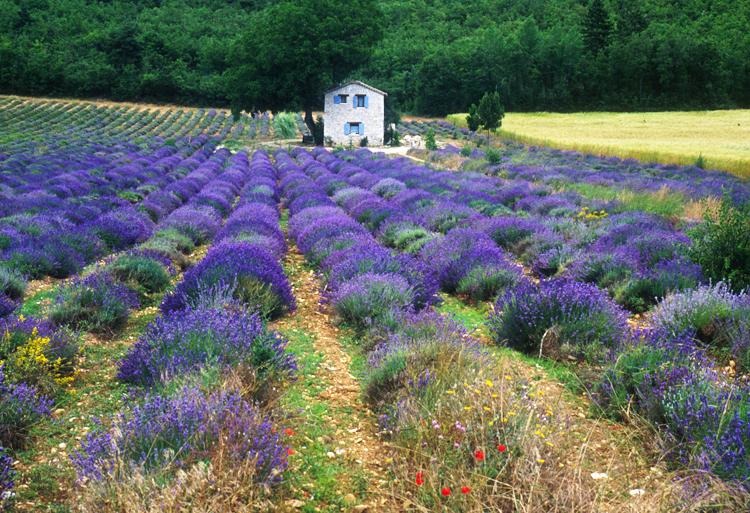Explorations in Aromatherapy Winter 2014
Rose – Eternal Fascination
 Rosa centifolia literally means Rose with a hundred petals. It is a hybrid developed between the 17th and 19th century. Rosa centifolia has been widely cultivated in Provence, especially the areas surrounding the city of Grasse for its singular fragrance with very bright high notes.
Rosa centifolia literally means Rose with a hundred petals. It is a hybrid developed between the 17th and 19th century. Rosa centifolia has been widely cultivated in Provence, especially the areas surrounding the city of Grasse for its singular fragrance with very bright high notes.
Extracts of Rosa centifolia are commonly used in the formulation of so-called communels, Rose absolutes composed of different Rose varieties – i.e. R. damascena – from different growing regions in which the manufacturer attempts to create a Rose absolute of constant odor quality.
As a result pure Rosa centifolia absolute is rarely offered, not the least because its low yield renders it more expensive than the blended Rose absolute.
So when a pure Rosa centifolia absolute became available we were mesmerized by its incredibly bright high notes.
We now also have a pure Rosa damscena absolute to compare. Both absolutes are from Morocco.
Helichrysum 2014

There is probably no other oil in current circulation, which so predictably and reliably heals and rejuvenates the skin like Helichrysum italicum. As many in aromatherapy are aware, Helichrysum essential oil is an ingredient in a successful cosmetic line of L’Occitane, the multinational company originating from Provence. In this context there is an interesting First. Let me explain. Over the years we have had almost count
less inquiries from all different interests about wanting to purchase essential oils for the creation of a new and ultra natural, ultra pure line of cosmetics. However, whenever the crucial decision making nears corporate sponsors, without exception, have opted to ultimately formulate the new product not with authentic oils, perceived to be to expensive, but with the usual industrial products from the large brokerages. With L’Occitane this changes. Apparently they are procuring authentic Helichrysum oil wherever they can find it. It appears to be a two sided affair. On the one hand there is a corporate entity that understands that authentic oils will do things that synthetics will not. On the other hand this means that for the foreseeable future the price of this precious commodity will move only in one direction, up.
We realize that our new prices for this oil must seem high, but given the current market situation we expect that prices will still move higher.
Oils from the East
For a while now we have been offering CO2 Extracts of some Asian aromatic plants. Exploring their therapeutic potential and, if you will, their philosophical implications is rewarding for everyone devoted to essential oils and aromatherapy.
Turmeric (Curcuma longa) is indigenous to India. Its extract contains a high proportion of Turmerones and traces of Curcumin. It is used as antiinflammative, anti-oxidant, antimicrobial and in detoxifying compositions. There have also been studies demonstrating the anti-wrinkle properties of Turmerones. Apparently it also works well to calm inflamed gums.
Javanese Turmeric – Curcuma xanthorrhiza
Javanese Turmeric or Temu Lawak contains mainly sesquiterpenes – aryl-Curcumene, ß Curcumene and 15 – 25 % Xanthorrhizol (Hydroxy-aryl-Curcumene) – and is soothing and calming. It is used in anti-inflammative, anti oxidant and detoxifying compositions. It is used in mouth care for its efficacy against staphylococcus mutans and other oral pathogens. Studies have been conducted showing the whole spice’s liver protective qualities (whether these apply to the extract is not ascertained).
Galangal – Alpinia galanga
Alpinia galanga extract is pungently spicy and can produce quite a sting in the nose when sniffed or inhaled incautiously. It is mainly used in compositions against nausea, vomiting, digestive disorders and arthritis. The extract, properly blended has balancing antimicrobial and anti-inflammative properties.
Fenugreek – Trigonella foenum graecum
Fenugreek extract contains mostly fatty acids, 30 – 40% Linoleic acid and 30 – 40% Linolenic acid. Traces of Sotolon are responsible for the typical aroma. The steroid Diosgenin, to which current research attributes some of the more astonishing properties of Fenugreek Seeds is apparently not present in the extract or if so, only in traces.
Schizandra sphenantera
Schizandra extract contains rare lignans, sitosterol, terpenoids and linoleic acid. It is relaxing and tonifying, minimizes the influence of stressors, stabilizes the membrane. It is a COX-2 inhibitor and has antioxidant, anti-hepatotoxic anti-asthmatic and antidiabetic properties.
Cassia – Cinnamomum cassia
Cassia extract contains up to 75% Cinnamic aldehyde, Methoxy cinnamic aldehyde and around 2% of Coumarin. It can be added to mouth wash compositions or to carminatives.
Calamus – Acorus calamus
Calamus extract contains about 65% essential oil components. Different to the essential oil the fragile sesquiterpene lactones, the acorones, especially acoragermacron remain intact.
Indian Frankincense (Boswellia serrata)
Indian Frankincense extract contains up to 85% mono terpenoids but also the sesquiterpene alcohols and esters including incensole acetate. The content of Boswellia acids is below 0.1%.
Guggul (Commiphora mukul)
Guggul extract is derived from Commiphora mukul and contains about 2% Guggulsterone. Recent research credits it with anti tumor anti-inflammative cholesterol lowering and antidiabetic properties. Other studies show that it supports the transformation of adipose tissue. It regulates glucose and fat metabolism and is seen as useful addition to therapies for type II Diabetes, high cholesterol, excess weight and metabolic syndrome.
